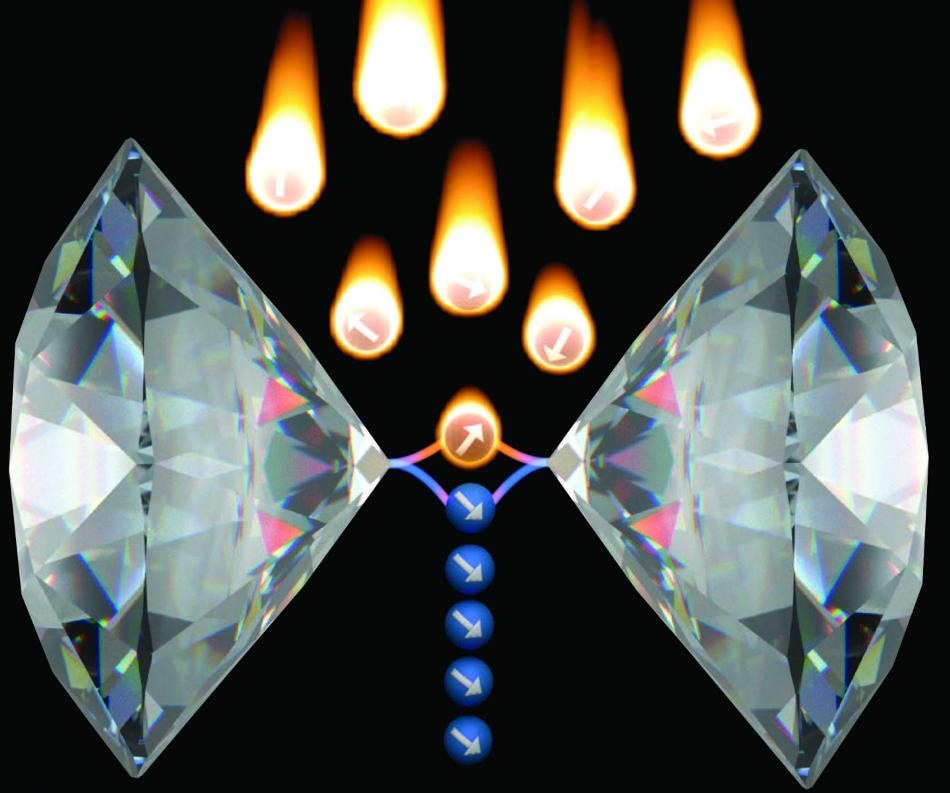Mar 30 2018
Scientists from the University of Melbourne have devised a method which might increase the sensitivity of magnetic resonance imaging (MRI) for the diagnosis of patients.
 Schematic representation of quantum hyperpolarization. Nuclear spins with random magnetic orientation (“hot”) are subjected to a controlled interaction with atomic defects in diamond which aligns (hyperpolarizes) their spins (“cold”) and amplifies their magnetic signal. (Image credit: David Broadway, University of Melbourne)
Schematic representation of quantum hyperpolarization. Nuclear spins with random magnetic orientation (“hot”) are subjected to a controlled interaction with atomic defects in diamond which aligns (hyperpolarizes) their spins (“cold”) and amplifies their magnetic signal. (Image credit: David Broadway, University of Melbourne)
The innovative method functions by improving the strength of the magnetic field generated by molecules, thereby increasing their signal that is measured by MRI.
The researchers formed particular flaws in diamond crystals that led to a controlled quantum mechanical influence over the nuclear spins in adjacent molecules, including conceivably those used in metabolic imaging of brain tumors, resulting in “line up” (polarization) of these molecules in a particular orientation.
Such a hyperpolarized state of nuclear spins is exceptionally ordered and increases the magnetic field, which can be detected by methods such as MRI.
For the first ever time, the researchers have demonstrated this polarization of molecular nuclei using such a diamond-based quantum probe.
Professor Lloyd Hollenberg, researcher at the University of Melbourne School of Physics, headed the research team, and the study was reported in the Nature Communications journal.
According to Professor Hollenberg, CQC2T Deputy Director and Thomas Baker Chair at the University of Melbourne, the most efficient MRI scanners in the world are at present approaching the maximum magnetic field that could be tolerated by the human body since the technology aims to achieve higher sensitivity.
The superconducting magnets that produce these fields are also the reason MRI scanners cost millions of dollars, as the magnets need to be kept at cryogenic temperatures.
Clearly a disruptive approach is needed, so we look to using quantum technology to produce a greater signal intensity of certain molecular targets at the atomic level.
Professor Hollenberg.
David Broadway, a PhD candidate from the University of Melbourne, stated that the method was put to work by using a fridge magnet and a little atomic-level quantum mechanics.
“We can think of the atom’s nuclei like a compass needle that produces a magnetic field that depends on its orientation,” stated Mr. Broadway.
“When there are several compass needles pointing in different directions, the resulting field tends to average to zero, but when the compasses point all in the same direction the contributions to the field from each compass needle will add up to something measurable,” he added.
“So having the nuclei all lined up makes the magnetic field stronger and therefore the MRI reading it can pick up more detail.”
“Currently, MRI’s can get about one in a million nuclear spins to line up, whereas our method could achieve nearly 100 percent to line up within molecules, potentially enhancing the imaging sensitivity by orders of magnitude.”
The modified diamonds can be used to develop a “quantum hyperpolarization” chip, over which a target molecular contrast agent can be made to flow. The quantum mechanical interaction between the target and quantum probes is exploited to transfer the polarization from the diamond to the agent, which can be injected into, or inhaled by, a patient before carrying out their MRI. The polarization is retained by the agent adequately long to, for instance, move to a tumor site, rendering it simple to be imaged through MRI.
Dr. Liam Hall, a postdoctoral researcher, stated that this type of imaging is already being employed by MRI-based precision medicine. However, the cost of the needed infrastructure can be competitive to that of the MRI scanners.
“Additionally, we would only use light shone through diamonds in the quantum mechanical production of polarised contrast agents already approved for routine use. So nothing toxic would enter the body,” stated Dr. Hall.
“The technique came out of our work in developing quantum sensing technology, and the realisation that these diamond-based quantum probes can exert a powerful influence on surrounding nuclear spins when we optimise the conditions under which they directly ‘talk’ to each other,” stated Dr. Hall, who introduced the theoretical concept.
“In a sense, the quantum probe extracts random spin disorder from the (‘hot’) target molecule to produce an ordered (‘cold’) spin-aligned state. The potential for application in hyperpolarisation for MRI soon became clear.”
The experimental demonstration clearly exhibits the power of the quantum method.
According to Professor Hollenberg, “To put it in context, to achieve the same level of polarisation with a conventional approach, we’d need to increase the magnetic field by a factor of about 100,000 times, and you’re only going to find fields like that in a neutron star.”
Methods for hyperpolarizing nuclear spins could find a number of significant applications in the life and physical sciences.
Hyperpolarized metabolites, when injected into patients, move to tumor sites, which could then be monitored in real-time with MRI as they are metabolized. Hyperpolarized gases can be inhaled for performing MRI imaging of lungs and their functionality. Both the methods have pivotal roles in the emerging era of personalized medicine.
Hyperpolarization of target molecules also enhances the signal-to-noise ratio of high-resolution nuclear magnetic resonance (NMR) spectroscopy, rendering it an essential tool for analyzing complicated biomolecular systems.
“Clearly the next step, which we are heavily focused on, is to repeat this process using macroscopically sized engineered arrays of these quantum probes in diamond to scale this technology up,” stated Professor Hollenberg.
“More probes equals more polarisation and more contrast agent molecules produced, but the probes start to upset each other quantum mechanically if they are packed in too closely, so we need to find the right balance.”
“If we can tick that box, we can then think about polarising volumes of MRI contrast agents that are detectable by the MRI scanners found in research labs and hospitals.”